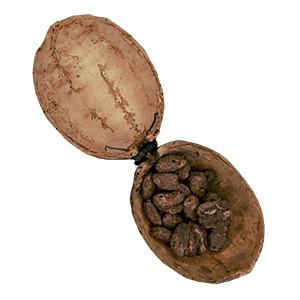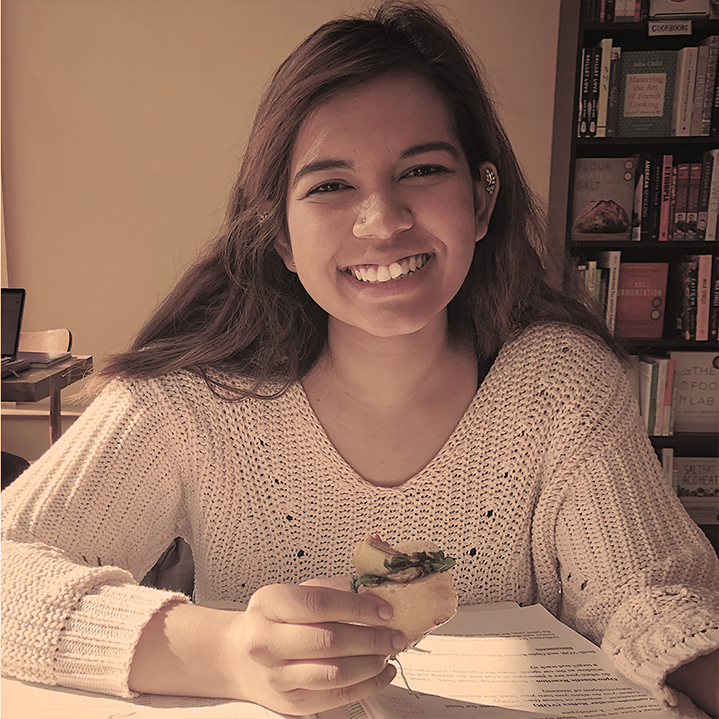 This cacao pod, ingeniously converted into a hinged box to store the plant’s seeds, made its way to the Academy of Natural Sciences at Drexel University from the island of St. Croix through the naturalist Peter A. Browne. During his residence on the island from October 1841 to May 1842, Browne studied St. Croix’s flora, culminating in a handwritten 1842 catalogue of West Indian plants, now held in the Academy’s Archives. Of the “Chocolate Tree,” or Theobroma cacao, Browne wrote in this volume: “The nuts grow in clusters of from 40 to 50 enclosed in a hard oval seed vessel.” Before this plant became a specimen, its beans resided in a sweet and edible white pulp within the large pod, the latter of which would have resembled an autumn squash in color and a football in shape. Given that “seed vessels” were one of Browne’s botanical subjects of focus, his ultimate preservation method makes a visual pun by converting a natural seed vessel into an archival vessel: a sealed container that has cradled these seeds for posterity.
This cacao pod, ingeniously converted into a hinged box to store the plant’s seeds, made its way to the Academy of Natural Sciences at Drexel University from the island of St. Croix through the naturalist Peter A. Browne. During his residence on the island from October 1841 to May 1842, Browne studied St. Croix’s flora, culminating in a handwritten 1842 catalogue of West Indian plants, now held in the Academy’s Archives. Of the “Chocolate Tree,” or Theobroma cacao, Browne wrote in this volume: “The nuts grow in clusters of from 40 to 50 enclosed in a hard oval seed vessel.” Before this plant became a specimen, its beans resided in a sweet and edible white pulp within the large pod, the latter of which would have resembled an autumn squash in color and a football in shape. Given that “seed vessels” were one of Browne’s botanical subjects of focus, his ultimate preservation method makes a visual pun by converting a natural seed vessel into an archival vessel: a sealed container that has cradled these seeds for posterity.
Browne is best known not as a botanist, but as a proponent of racial science. He assembled specimens of hair, ranging from that of enslaved individuals to multiple U.S. presidents, and analyzed hair’s supposed racial characteristics to support the theory of polygenesis, or the idea that races were separate species rather than varieties of one human species. Browne’s method involved not only collecting specimens, but also classifying them. He organized his human hair specimens into three types, as outlined in his 1853 book Trichologia Mammalium. Browne also corresponded with Josiah C. Nott, an Alabama physician who co-authored one of the most famous polygenecist tracts, Types of Mankind, in 1854. While Browne wrote in his catalogue that “custard apples are eaten by the blacks,” and he observed how other West Indian plants were used as food or medicine by the local enslaved populations, he does not offer information about the individuals who ate and cultivated cacao on the island of St. Croix.

The entry for cacao in Peter A. Browne’s Catalogue of Plants, Woods, Seeds, &c. &c. Collected in the West India Islands… (1842). Coll. 319, The Academy of Natural Sciences of Philadelphia, Academy Archives.
But histories of slavery are nevertheless contained within the pod—and not solely through the racist predilections of its maker. Christopher Columbus visited St. Croix in 1493, and centuries later the Danish West Indies Company purchased the island from France in 1733. By 1800, the population of St. Croix boomed to 30,000 people, the vast majority of them enslaved. St. Croix’s position as one of the wealthiest countries in the West Indies derived its value from the exportation of sugar, rum, cotton, molasses, and hard woods, and the exploitation of enslaved labor to cultivate these items. Slavery was not abolished on the island until 1848, several years after Browne’s visit. Although cacao was not one of the major commodities grown by the enslaved population of St. Croix, historians such as James Delbourgo have shown that enslaved individuals routinely cultivated cacao throughout the early modern Americas, a task that required tremendous skill and dexterity. Sir Hans Sloane, an Anglo-Irish physician, naturalist, and collector who relied on the knowledge of enslaved peoples in Jamaica whom he had met during the late seventeenth century, also popularized milk chocolate as a health drink.
The cacao beans that remain in Browne’s pod vessel today are the raw materials out of which such products would have been produced, although they were edible in and of themselves. However, the once-standard practice of treating museum plant specimens with toxic compounds such as mercuric chloride—used to deter insects from eating them—makes specimens such as these cacao seeds unwise for consumption today.
This cacao capsule, doubling as a time capsule, does not simply preserve past stories of racial science and early modern slavery. Like the breadfruit featured in this exhibition, it also highlights complicated meanings and relationships between certain foods and the descendants of enslaved peoples. For example, an undergraduate student from Barbados who had taken Dr. Carla Martin’s class Chocolate, Culture, and the Politics of Food at Harvard University writes of her own “complicated relationship with chocolate and sugar during [her] childhood,” a relationship “entwined with stories of the colonized bodies of my ancestors,” as “the bodies of black and brown people were used for European gain.” The pod, moreover, questions the continued exploitation of individuals, including children, who labor to grow cacao today, along with the environmental degradation wrought by the plant’s cultivation.
Thus, the French writer J. H. Bernardin de Saint-Pierre’s observations from 1773 about coffee and sugar—which formed the epigraph to anthropologist Sidney Mintz’s monumental Sweetness and Power—eerily ring true for the afterlife of cacao cultivation as well. “I do not know if coffee and sugar are essential to the happiness of Europe,” he wrote, “but I know well that these two products have accounted for the unhappiness of two great regions of the world: America has been depopulated so as to have land on which to plant them; Africa has been depopulated so as to have the people to cultivate them.”
Image: Cacao pod box donated by Peter A. Browne from St. Croix, early 1800s. The Academy of Natural Sciences of Drexel University Botany Department (PH00761995). Photograph by Jordan K. Teisher.
 This article was written by Fatema Begum. For more information about her work and her other contributions to The Kitchen in the Cabinet click here.
This article was written by Fatema Begum. For more information about her work and her other contributions to The Kitchen in the Cabinet click here.
References
Anonymous. “A Complicated History of Chocolate and Sugar in the Caribbean (and Abroad).” Chocolate Class: Multimedia Essays on Chocolate, Culture, and the Politics of Food. May 12, 2018. https://chocolateclass.wordpress.com/2018/05/12/a-complicated-history-of-chocolate-and-sugar-in-the-caribbean-and-abroad/.
Belardo, Carolyn. “Historic Hair Collection.” The Academy of Natural Sciences. October 31, 2018. https://www.anspblog.org/historic-hair-collection/.
Browne, Peter Arrell. Catalogue of Plants, Woods, Seeds, &c. &c. Collected in the West India Islands… 1842. Collection 319. The Academy of Natural Sciences of Drexel University, Philadelphia, PA.
Browne, Peter Arrell. Trichologia Mammalium; A Treatise on the Organization, Properties, and Uses of Hair and Wool; Together with an Essay upon the Raising and Breeding of Sheep. Philadelphia: 1853.
Briggs, D. et al. “Mercury Vapour: A Health Hazard in Herbaria.” New Phytologist 94, no. 3 (July 1983): 453–57.
Delbourgo, James. “Sir Hans Sloane’s Milk Chocolate and the Whole History of the Cacao.” Social Text 29, no. 1 (Spring 2011): 71–101.
Minella, Timothy. “By Their Locks You Shall Know Them: Race, Science, and Hair in the Nineteenth Century.” Consortium for History of Science, Technology and Medicine. https://www.chstm.org/news/their-locks-you-shall-know-them-race-science-and-hair-nineteenth-century?fbclid=IwAR2mQIwA_SgNWUKXq2ToaVNfHb5SvYRnCu_Sv–hRA5CSks0PGPSPtB3-gc.
Mintz, Sidney Wilfred. Sweetness and Power: The Place of Sugar in Modern History. New York: Penguin Books, 1986.
de Orellana, Margarita et al. “Chocolate: Cultivation and Culture in Pre-Hispanic Mexico.” Artes de México, no. 103 (September 2011): 65–80.
Shaw, Earl B. “St. Croix: A Marginal Sugar-Producing Island.” Geographical Review 23, no. 3 (July 1933): 414–22.